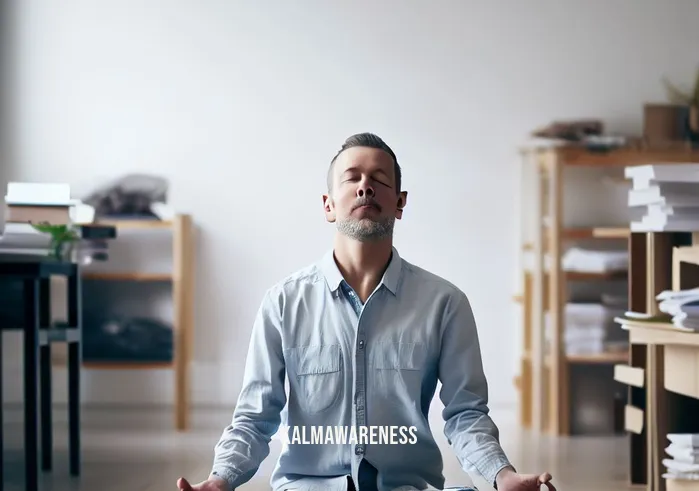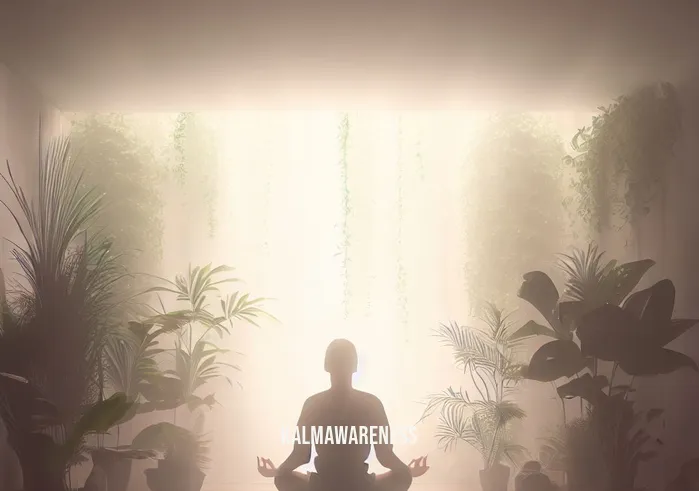Can You Lay Down While Meditating? Exploring the Versatility of Mindfulness Practices
Introduction to the Question: Formality and Flexibility
In the diverse landscape of mindfulness and meditation, a common question often arises: can you lay down while meditating? The curiosity stems from a blend of tradition and modern adaptations, often leaving practitioners in a whirlpool of confusion. Traditional meditation practices have often emphasized the importance of an upright seated position. Yet, as mindfulness and meditation adapt to contemporary life, we find various forms and methods that encourage us to involve attaining a peaceful state of mind in which thoughts are not occupied by worry. Is it possible, then, to find rest and relaxation while lying down during meditation?
The Traditional Standpoint
In most traditional meditation settings, sitting upright is considered the optimal posture. This comes from the belief that an upright position promotes alertness and focus. Often, practitioners are encouraged to sit on a cushion or chair, keeping the back straight and eyes closed or half-open. According to experts like Jack Kornfield, who provides meditation guides for beginners, the upright position creates an environment conducive for mindfulness.
“In seated meditation, the nexus between your mind and body is where your focus lies. A straight back, open chest, and grounded feet are all elemental aspects that enhance your meditative experience.”
Arguments for Reclining Meditation
However, the inquiry about whether one can meditate while lying down comes from a valid place, especially given the evolving adaptations in meditation techniques. After all, methods like EMDR meditation or even mindful hypnobirthing deviate from conventional sitting methods to fit specific needs. So why not explore the feasibility of reclining meditation?
Advocates of reclining meditation highlight its benefits for individuals who have back issues or other physical constraints. For some, lying down might be the only comfortable position available, and sustainable self-care demands adapting practices to one’s needs.
The Intersection of Rest and Mindfulness
It’s important to separate the concept of reclining meditation from lying down to rest or sleep. While lying down can be restorative, it should not be confused with a 15-minute power nap. The emphasis is still on mindfulness, and activities like mindful movement in sleep are distinct yet related topics. When you decide to meditate while lying down, the primary objective remains to engage in a focused breathing and meditation routine that allows you to be present in the moment.
Tips for Successful Reclining Meditation
- Environment: Choose a clean, quiet space free of distractions.
- Posture: Lay down flat on your back, either on a bed or yoga mat.
- Focus: Begin with breathing exercises, gradually working towards deeper levels of relaxation.
Wrapping Up and What’s Next
To answer the question—can you lay down while meditating?—it’s a resounding yes, but with conditions. While traditional methods have their merit, the world of mindfulness is vast, accommodating a range of techniques that can be modified to suit individual needs. In the upcoming segments, we’ll explore the relationship between body awareness and reclining meditation, the science behind it, including the benefits of specific frequencies like 256 Hz, and how to incorporate it into a routine effectively.
Interested in diving deeper? Continue reading to unlock the full potential of reclining meditation and how it aligns with the principles of rest, relaxation, and peace.

The Science and Practicality Behind Reclining Meditation: Debunking Myths and Setting Facts Straight
Unveiling the Importance of Reclining Meditation
Understanding the relevance of the question, can you lay down while meditating, becomes crucial when we delve into the needs and constraints of modern life. While traditional sitting meditation unquestionably offers a plethora of benefits, it’s essential to recognize that reclining meditation is not a mere afterthought. In fact, it serves as a practical adaptation for those who face physical challenges or just need a different approach to mindfulness.
Body Awareness: A Pivotal Element
Lying down during meditation facilitates greater body awareness. This approach lends itself to a variety of meditation practices that specifically focus on body scans or progressive relaxation techniques. As you lie down, it becomes easier to pay attention to different parts of the body sequentially, enhancing the overall mindfulness experience.
The Frequency Connection
Different meditation styles and practices have their unique frequency ranges that can enhance the experience. For instance, some guided meditations use a frequency of 256 Hz to facilitate deep relaxation. When lying down, your body is more attuned to receive these frequencies, elevating the quality of your meditative state.
Comparative Analysis: Sitting Vs. Lying Down
| Position | Pros | Cons |
|---|---|---|
| Sitting | Promotes alertness, widely accepted in various traditions | Can be uncomfortable for people with back issues |
| Lying Down | Comfortable, enhances body awareness, good for specific frequencies | Risk of falling asleep, not suitable for certain meditation types |
Debunking Common Misconceptions
Falling Asleep is Not Mindfulness
One of the most significant reservations people have about reclining meditation is the possibility of falling asleep. While lying down could make you more prone to snoozing, the objective remains mindfulness, similar to how we attain deep levels of relaxation so quickly in certain meditation forms.
A Position of Choice, Not Laziness
Reclining meditation should not be perceived as a ‘lazy’ alternative to sitting. It’s about catering to individual needs, aiming for sustainable self-care.
Daily Incorporation: Where Does It Fit?
While contemplating if you can lay down while meditating, another aspect to consider is its applicability in daily life. The answer is a resounding yes, as you can integrate this practice into various moments of your day:
- Morning Mindfulness: Start your day with a sense of calm.
- Midday Reset: Ideal for a quick meditation session during your lunch break.
- Evening Relaxation: Before bed to enhance the quality of your sleep.
It can even be part of your teenager’s walking or movement-based mindfulness routine, serving as a calming cool-down activity.
What Awaits in the Next Chapter
While we’ve explored the various facets of reclining meditation, it’s important to recognize that individual experiences may vary. So, how can you fine-tune this form of meditation to your specific needs? In the next chapter, we will delve into the nuances of reclining meditation techniques that cater to various personal preferences and situations. From understanding how to stabilize your practice to incorporating elements of rousing yoga for a complete mind-body experience, there’s a lot more to unfold.
So, continue reading to unlock the deeper layers of reclining meditation, ensuring that you’re not merely lying down but lying down with purpose and mindfulness.

Harnessing the Power of Reclining Meditation for Hope and Inspiration
When Lying Down Becomes a Transformative Journey
The query—can you lay down while meditating—takes on an entirely new dimension when viewed through the lens of personal development and inspiration. We’ve established that reclining meditation is a legitimate and effective way to cultivate mindfulness. Yet, beyond its practical aspects, what else does this form of meditation offer in terms of hope and inspiration? How can this adapted posture inculcate a sense of peace and clarity that transcends the physical act of lying down? Let’s find out.
“Find Your Own Way”: Quotes on Hope and Reclining Meditation
The wisdom found in insightful quotes can offer a fresh perspective on the art of reclining meditation. Here are a few thought-provoking quotes that resonate with this meditation style’s inspirational aspects:
“Peace comes from within. Do not seek it without.” — Gautama Buddha
- This quote encapsulates the essence of reclining meditation. Whether you’re seated or lying down, internal peace is the ultimate goal.
“Sometimes the most important thing in a whole day is the rest we take between two deep breaths.” — Etty Hillesum
- When you meditate while lying down, this pause and focus on breath offer invaluable reprieve and restorative energy.
“The body benefits from movement, and the mind benefits from stillness.” — Sakyong Mipham
- As you lie down, your body is at rest, but your mind can actively engage in sustainable self-care and mindfulness.
“The quieter you become, the more you can hear.” — Ram Dass
- Reclining meditation allows you to escape from the judgment of the wise and focus solely on the voice within.
Aligning Your Stars: The Inspirational Element
Lying down during your meditation sessions allows you the physical comfort to explore mental and emotional terrains more freely. Often, inspiration strikes when we are at ease, unburdened by the strictures of posture or environment. The peace attained from reclining meditation aligns well with the broader definition of mindfulness, which encourages a holistic view of well-being.
Peace in Every Breath: Turning the Ordinary into Extraordinary
It’s easy to overlook the power of a simple action like lying down. Yet, when coupled with a purposeful mindfulness practice, it becomes a form of beautiful simplicity in meditation. Each breath becomes a moment of peace, each thought a flicker of inspiration. It transforms the mundane act of lying down into an extraordinary journey towards inner peace.
Teasing What’s Ahead: Unveiling the Unspoken Benefits
So far, we’ve traversed the terrains of the practical, the scientific, and the inspirational in reclining meditation. Yet, we have only scratched the surface. Could there be even more unspoken benefits and secrets to unlocking the fullest potential of this form of mindfulness? In the next chapter, we’ll dig deeper into some lesser-known facets, such as how to infuse your reclining meditation practice with elements that make it much more than a simple relaxation technique.
Embark on the continuing journey to discover the full richness that reclining meditation has to offer. It promises to be an eye-opening revelation that will transform how you perceive this lying-down form of mindfulness. Continue reading to find out more.

The Anatomy of Reclining Meditation: A Comprehensive Look
Unpacking the Elements of Meditating While Lying Down
As we delve deeper into our discussion on whether you can meditate while lying down, it becomes crucial to unpack the anatomy of this approach. In previous chapters, we’ve explored the legitimacy, the inspirational facets, and even the scientific backing for reclining meditation. Now, let’s break down the components and techniques that make this form of mindfulness both unique and effective.
Understanding the Core Components
Understanding the key aspects of reclining meditation can help you get the most out of your practice. These components are often overlooked but are essential in elevating your experience from mere relaxation to a meaningful mindfulness endeavor.
- Breathing Techniques: One of the cornerstones of any meditation practice, your breathing method can affect how deeply you go into a meditative state. Techniques like diaphragmatic breathing and 4-7-8 breathing can be especially useful in reclining positions.
- Muscle Engagement: Unlike traditional seated meditation, reclining meditation allows for more muscle groups to be at rest, encouraging a deeper state of relaxation.
- Mental Focus: Even while lying down, maintaining a peaceful state of mind is key.
- Body Awareness: As you lie down, focusing on different body parts can be a powerful meditation exercise. This touch-that-body-part technique can be particularly useful.
Techniques for Effective Reclining Meditation
When practicing meditation while lying down, consider these techniques for a fulfilling experience:
- Body Scans: Systematically scan your body from head to toe, noting any tension or discomfort.
- Guided Imagery: Use mental images to transition your mind into a more serene place.
- Progressive Relaxation: Tighten and release muscles in a sequential manner to attain deep relaxation.
- EMDR Meditation: Eye Movement Desensitization and Reprocessing can also be adapted for lying-down meditation.
What the Experts Say: Advanced Techniques
For those who have mastered the basics, experts recommend taking your practice to the next level with these more advanced techniques:
- Mindful Hypnobirthing: Ideal for expecting mothers looking to combine relaxation and mindfulness.
- Rouse Yoga Techniques: Incorporate yoga techniques to deepen your practice.
- 256 Hz Sound Therapy: Use specific sound frequencies to enhance your meditation experience.
Teasing the Final Frontier: The Ultimate Mind-Body Connection
As we’ve dissected the many facets of reclining meditation, it becomes clear that this practice is a treasure trove of opportunities for personal growth and enhanced well-being. But as comprehensive as our exploration has been, there’s still one more critical angle we’ve yet to discuss: How does reclining meditation fit into a lifestyle aiming for total mind-body balance?
In the final chapter, we’ll draw connections between reclining meditation and broader lifestyle changes. We’ll delve into how lying down to meditate can be a transformative habit that contributes to a holistic wellness strategy, encompassing both physical exercise like walking and short rejuvenative practices like power naps. Get ready to discover how this simple practice can be the cornerstone of a balanced, fulfilling life. Continue reading to learn more.

Unfolding the Mat: The Last Word on Meditating While Lying Down
Unraveling the Myths: The Final Verdict on Lying Down While Meditating
As we close this in-depth exploration on whether one can engage in reclining meditation, it’s worth revisiting some of the key takeaways. This journey has brought us from questioning the very legitimacy of lying down while meditating to discussing its nuances, techniques, and even its incorporation into a balanced lifestyle. So, can you lay down while meditating? The answer, unequivocally, is yes! The form may differ from traditional seated meditation, but the essence remains rooted in the quest for mindfulness and inner peace.
To Lie or Not to Lie: The Relevance of Posture in Meditation
Often, the most sustainable self-care practices are those that seamlessly integrate into our daily lives. Reclining meditation does precisely that. While other forms of meditation require a certain posture or environment, lying down offers a more flexible approach. Its adaptability is key to its sustainable self-care appeal. If you’re new to meditation and find it challenging to sit for extended periods, a lying-down posture might be a great starting point. Resources like Jack Kornfield’s Meditation for Beginners can guide you through the process.
In Conclusion: The Comforting Embrace of Reclining Meditation
Our journey has been enlightening and, hopefully, inspiring. Embracing meditation in a reclining posture is less about breaking the rules and more about understanding that the ultimate aim of meditation is mindfulness and inner stability. So, whether you’re looking for a way to incorporate mindful movement into your sleep routine or seeking to add another layer to your meditative practices, lying down to meditate holds its own merits.
A Cheerful Farewell and An Invitation for More
Dear readers, thank you for sharing this journey with us. We’ve delved deep into a topic that often provokes mixed opinions, and hopefully, we’ve offered some clarity and inspiration. It’s not just about the posture; it’s about the intention and focus that you bring into the practice. So, take a moment to be peaceful and contemplate what you’ve learned. As always, we encourage you to continue your exploration of meditation and its various facets by revisiting previous sections or diving into other rich content on our platform.
Thank you for spending your valuable time with us. We’re thrilled to have you as part of our community and look forward to providing even more insightful content in future editions. Until then, keep exploring, keep questioning, and above all, keep meditating in whichever way brings you peace.
Your Next Steps: A Call to Action
Excited about what you’ve learned? Here’s how to continue your journey:
- Revisit previous sections for a refresher or to dive deeper into the techniques and ideas discussed.
- Explore our magazine’s comprehensive collection of articles on meditation and mindfulness.
- Join our community discussions and share your experiences. Your insights might be the missing piece someone else needs to enrich their practice.
Happy meditating, everyone! 🧘♀️🧘♂️





